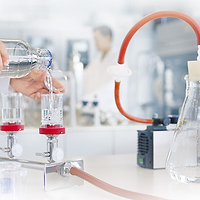Analysis of Antioxidant Properties of Popular Beverages

Introduction
Antioxidants are molecules capable of slowing or preventing the oxidation of other molecules, therefore protecting cells from oxidation damages. There are many claims that various teas and juices have antioxidant properties. Using a simple analysis, we are able to determine the antioxidant properties of several beverages.
Commonly known examples of antioxidants are vitamins E and C, uric acid, carotenes and glutathione. Total antioxidant capacity can be measured with a simple photometric assay based on the reduction of bivalent copper ion, Cu2+, to Cu+ by the antioxidants present on the sample. This reduced form of copper is then selectively bound to a chromogenic compound to form a complex that has strong absorbance at 490 nm.
Method
The antioxidant power of different beverage samples was determined using a photometric Total Antioxidant Power kit from Oxford Biomedical Research Inc., and a 96-well Thermo Scientific Immulon 1B microplate. The most commonly used reference antioxidant, Vitamin B analogue Trolox [(±)-6-hydroxy-2,5,7,8-tetramethylchromane-2-carboxylic acid] was used as a calibration standard. All beverage samples were diluted 1:10 for the testing and the assay was performed according to kit instructions using the Thermo Scientific Multiskan® FC photometer and the Thermo Scientific SkanIt® Software. After the measurement the background absorbance was subtracted from the final absorbance values and a linear calibration curve was prepared based on the standards. The antioxidant power of the samples was then resolved from the calibration curve as Trolox equivalents.
Analysis
 The antioxidant capacity of the samples was calculated automatically by SkanIt® software curve fit module. The module calculates the concentrations of samples based on the calibration curve and then calculates the final result value by taking the dilution factors into account. The resulting calibration curve is shown in Figure 1 and the final results are shown in Table 1.
The antioxidant capacity of the samples was calculated automatically by SkanIt® software curve fit module. The module calculates the concentrations of samples based on the calibration curve and then calculates the final result value by taking the dilution factors into account. The resulting calibration curve is shown in Figure 1 and the final results are shown in Table 1.

When we analyze the data from the measurements, one striking observation is the excellent precision of the reader with low level absorbences. The background values measured before the dye addition are clearly below 0.001 absorbance unit standard deviation in these blank values (n = 46). This exceptional low level precision improves the assay sensitivity as absorbance values very close to the background become statistically relevant and can be used for the real measurements. Calibration curve analysis shows that this assay offers exceptional performance with the Multiskan® FC reader. The calibration curve shows complete linearity over whole concentration range and the assay could even be done with a lower concentration range tested in this work.
Which Beverage is Best?
Green tea was shown to have the highest antioxidant capacity in this assay, which was expected because green tea has been well known to be a strong antioxidant. White tea was also a rather powerful antioxidant, where as orange and apple juices were the two least powerful beverages. The values are quite typical for the beverages analyzed. Large variations in the antioxidative capacity can be observed when other types of green, black or white teas, or juices, would have been used.
This analysis shows clearly how the antioxidant capacity of different samples can easily be measured with a simple photometric assay using Thermo Scientific Multiskan® FC photometer. The benefits of this assay are high throughput by using a microplate format, at a low cost with only basic instrumentation and simple low cost reagents required.
For the detailed information the full application note about this assay can be downloaded from: www.thermo.com/eThermo/CMA/PDFs/Various/File_8574.pdf.
www.thermo.com/mpi
Looking for a reprint of this article?
From high-res PDFs to custom plaques, order your copy today!








